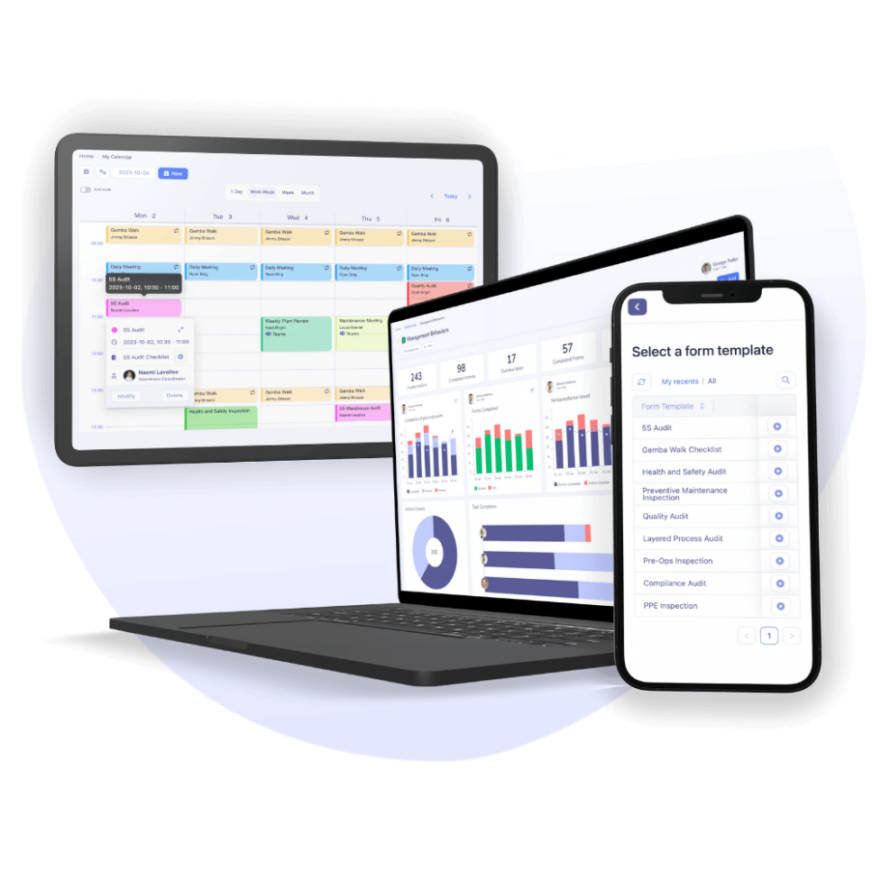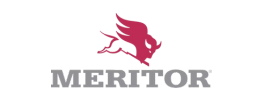Leader Standard Work (LSW): Blueprint for Lean Management

| Audience: | Manufacturing Managers, Healthcare Administrators, Operational Excellence and Lean Management Practitioners, HR Coordinators, Organizational Leaders |
| Last updated: | February 5, 2025 |
| Read time: | 9 min |
- Fundamental Components: Gemba Walks, recurring meetings, strategic planning, communication cascade, and monitoring performance indicators.
- Implementation: Standardizes leadership activities across all levels, from frontline supervisors to executives.
- Benefits: Reduces variations in management practices. Enhances problem-solving and accountability. Establishes operational control. Fosters continuous improvement.
Managers bring plenty of technical knowledge to the table, but without structure in place, their talent risks being wasted. For example, they might put essential leadership activities on the back burner in favor of tackling issues on the production floor.
Undoubtedly, mastering hard skills doesn’t necessarily translate into possessing soft skills. Not to mention that senior and newly promoted supervisors will certainly adopt different behaviors. This situation is quite challenging for organizations facing workforce turnover and labor shortages.
Typically, organizations standardize their employees’ work and daily activities with schedules, operating procedures, and performance management. But senior and newly promoted supervisors often choose to implement their own SOPs, and organizations dealing with turnover and staff shortages can quickly begin drowning in process variation.
So – how can you standardize management across different shifts and sites? This article provides detailed answers to these questions.
What is Leader Standard Work (LSW)?
Leader Standard Work (LSW) is an established set of routines, processes, and tasks that guide managers towards consistent and efficient performance on a daily, weekly, and monthly basis.
Its core purpose is to incorporate structured actions and tools into leadership practices to problem-solve faster, collaborate smarter, and keep everyone on the same page.
These routines, skills, and tasks can include collaborative efforts in recurring meetings (stand-ups or daily huddles) and observational methods like floor tours (Gemba Walks).
By establishing these actions as part of leaders’ daily work, LSW works to reduce variation in management practices while enabling continuous process improvement.
Leader Standard Work (LSW) Components
- Routines: Standardizing daily, weekly, and monthly workflows
- Skills: Developing leadership aptitudes and establishing priorities
- Tools: Equipping leaders to successfully navigate their routines
- Accountability: Creating accountability for performance targets

10 Steps to Implement Leader Standard Work in 4 Weeks
Importance of LSW
Standardization
LSW provides a framework for how team leaders, supervisors, and managers should execute daily, weekly, and monthly tasks.
Example: In manufacturing, implementing LSW involves standardizing checklists for equipment care. Maintenance teams know exactly when and how to conduct inspections, as well as how to escalate any issues they encounter along the way.
Leadership
LSW enables leaders at every level to prioritize the right objectives while actively supporting their teams. It also boosts performance by equipping them with operational routines, checklists, and structured tasks.
Example: Healthcare facilities use LSW to train senior personnel in coaching junior doctors, nurses, and administrators, fast-tracking onboarding and enhancing skill development.
Proactive Management
Proactive tasks like planning, coaching, and team support are the antidote to reactive “firefighting” mode. These processes guide managers around the workplace to identify issues and nonconformities, capture data, and log ideas for improvement before disaster strikes.
Example: Within a production line, leaders dedicate time to actively supporting assembly line workers. By conducting daily Gemba Walks and providing real-time guidance on process improvements, managers can optimize performance and encourage continuous skill development among their teams.
Continuous Improvement and Problem-Solving
LSW cultivates a culture of continuous improvement and problem-solving by implementing structured management routines. It establishes clear communication cascades and regular check-ins to increase collaboration and accelerate resolutions.
Example: LSW in a project management setting involves regular cross-functional team meetings to address project challenges. This practice encourages team members to solve problems collectively.

Relevant Tervene Tools
Implementing LSW
Implementing LSW involves a bottom-up approach, from operators all the way up to executives.
Leader Standard Work (LSW) for Different Levels
- Team Leader focus: Standardizing tasks like shift handovers, problem-solving methods, and daily routines. Team leaders spend around 80% of their time on standardized activities like process confirmation and coaching.
- Middle Management focus: Standardizing meeting structures, reporting mechanisms, and ensuring adherence to established procedures. Around 50% of middle management’s time is allocated to structured activities and reviews.
- C-Level Executive focus: Establishing consistent goal-setting processes and site visits. Executives allocate approximately 10% of their time overseeing strategy to ensure compliance with established standards and focus on long-term organizational objectives.

How to standardize leaders’ work
1. Create Structured Management Practices
LSW is meant to establish daily control, supervise activities, escalate issues, and ensure better communication between teams. It also formalizes how managers detect problems and follow up on corrective actions.
Daily checks (Proactive Gemba Walks)
- Process confirmation
- Team leader Gemba Walk
- Supervisor Gemba Walk
- Executive Gemba Walk
- 5S checklist
- Safety walk
Audits and recurrent inspections
- Quality inspection
- HACCP, ISO, SQF audit
- Health and safety inspection
- Equipment inspection
- Standard operating audit
- 5S audit
Visual management
- Monitoring KPI dashboards
- Monitoring supervisor performance
- 5S system
Tiered meetings structure
- Daily production meeting
- Shift handover
- Action follow-up
- Management committee
- EHS committee
- Improvement meeting
- 1:1 meeting
Procedures and Training
- Troubleshooting
- Operational procedures
- Setup (SMED)
- Employee evaluation
- Best practices
- Preventive maintenance
- Employee onboarding
- Training procedures
2. Equip Team Leaders and Directors with Management Tools
It’s nearly impossible to sustain high management standards with decentralized tools like SMS, email, paper-based inspections, whiteboards, sticky notes, and Excel. Over time, the need to transcribe, chase down, and locate information makes it impossible to work efficiently.
A digital daily management system increases supervisors’ adherence to management processes through structure and accountability. For example, read about how Kruger Products went digital to manage their day-to-day operations.
3. Establish Daily, Weekly, and Monthly Routines
An LSW Calendar is instrumental in defining managers’ recurring responsibilities, including regular inspections, audits, floor tours, and daily meetings. This calendar serves as a framework that defines management rituals and enables top-level leaders to monitor adherence levels, ensuring consistency and efficacy across the organization.

4. Establish Objectives and Performance Indicators
KPIs streamline the process of tracking departmental objectives by establishing clear goals, facilitating effective monitoring through quantifiable metrics, and promoting a sense of ownership and accountability, which leads to improved decision-making and resource allocation.
5. Promote Optimal Management Behaviors
Setting the standard for good management is how organizations boost their entire team’s performance. Recurrent 1:1 meetings facilitate objective discussions and prevent stagnation, and regularly refining standardized work keeps the entire operation running efficiently. All of this should be underpinned by structured coaching to help leaders understand their LSW objectives, develop their skills, and maintain accountability.
Personal development enables continual improvement, while initiatives like embracing letdowns for accelerated learning, skill enhancement, and promoting positive behavior contribute to leadership growth.
Standard Work vs. Leader Standard Work
Standard work focuses on operators’ and frontline employees’ procedures, such as detailed SOPs and 5S principles. LSW structures leaders’ schedule and guides their managerial behaviors.
This distinction allows standardization at all organizational levels:
- Operators: Schedule, work instructions, SOPs, proactive validation from supervisors, and 5S at workstations.
- Team Leaders and Supervisors: Inspections, Gemba Walk structure, daily meetings, supervision routine.
- Support Groups: Problem-solving process, issue escalation, and corrective actions.
- Managers and Directors: Department standardization, management committees.
- VP: Strategic alignment, corporate objectives, site standardization.
Comparison Chart
| Feature | Standard Work | Leader Standard Work (LSW) |
| Focus | Specific task execution for efficiency and quality | Leadership routines and behaviors to uphold a Lean culture and cultivate continuous improvement |
| Activities | Following detailed procedures (SOPs), schedules, 5S principles, and meeting performance targets | Gemba Walks, strategic direction setting, coaching, mentoring, problem-solving, supporting teams |
| Standardization | High level of standardization in daily tasks | Less precise, focusing on adaptable leadership actions and behaviors |
| Impact | Directly impacts production efficiency, quality, and output | Indirectly impacts performance by nurturing a culture of continuous improvement |
| Examples | Assembling a product, operating a machine, following a maintenance checklist | Conducting Gemba Walks, coaching team members, leading problem-solving sessions, setting goals |
Example of Leader Standard Work
Sarah, a newly promoted supervisor, sticks to a well-planned agenda for her first day of operations management on the manufacturing floor. Her morning routine begins with a proactive Gemba Walk to collect real-time operational insights. Then, she leads a quick production meeting to ensure the team is aligned and well-equipped to address immediate concerns.
In the afternoon, Sarah executes a second Gemba Walk and facilitates a seamless shift handover meeting to maintain operational continuity. Later that week, she dedicates time to a health and safety inspection and conducts a comprehensive 5S audit to uphold organizational standards.
For more LSW examples, visit our template hub, where you can explore a variety of structured daily work agendas tailored to different managerial roles.

Leader Standard Work Software
Benefits of standardizing managers’ work
There are plenty of benefits associated with LSW, including:
Aligning with Organizational Goals
Establishing standard practices based on your organization’s objectives ensures that managerial efforts are directly supporting overarching company goals.
Cultivating Problem-Solving Skills
LSW empowers leaders to use coaching as a springboard for developing problem-solving skills as a team.
Proactively Controlling Operations
System standardization provides managers with a framework for detecting and resolving issues instead of getting caught off-guard.
Streamlining Employee Onboarding and Workplace Safety
Implementing LSW streamlines operations, accelerates employee onboarding, and promotes a safer workplace environment.
Engaging in Continuous Improvement
LSW engages entire teams, from the bottom up, in ongoing process-driven problem-solving efforts. It also cultivates a blame-free environment by shifting focus from individuals to systemic enhancements.
Enhancing Response Agility
By prioritizing process-based problem-solving over individual attributions, LSW cultivates enhanced response agility, eradicates silos, and instills a culture of accountability.
Connecting LSW and DMS
Leader Standard Work and Daily Management Systems share a profound connection: both work to shape an organization’s culture and drive continuous improvement.
Foundation of Lean Leadership Routines and Culture
As a set of structured routines that guide managerial tasks, LSW creates a foundation for consistent leadership. Integrated seamlessly within a DMS, LSW encompasses essential practices like daily accountability processes, Gemba Walks, and process confirmation.
Catalyst for Accountability and Alignment
Both LSW and DMS reinforce accountability within an organizational framework. LSW’s emphasis on setting standards and enabling continuous improvement aligns seamlessly with the accountability-driven nature of the DMS. Additionally, both systems ensure leaders’ engagement in activities that align with organizational strategies.
Enabling Leadership Traits through LSW and DMS
LSW shapes leadership behaviors by promoting practices such as Gemba Walks and structured tiered meetings. Furthermore, both systems aim to foster a culture of excellence, aligning efforts toward continuous improvement and problem-solving.
In essence, Leader Standard Work acts as the guiding principle, setting expectations and behaviors for leaders. At the same time, the Daily Management System provides the structure and processes for leaders to enact and sustain those behaviors.
How technology can help uphold management standards
Digital solutions streamline LSW by providing centralized documentation, real-time updates, collaboration tools, and robust data analysis capabilities. They alleviate administrative burdens associated with analog operations, such as transcription and follow-ups, and enable data analysis at a scale that would otherwise be impossible.
These tools streamline Leader Standard Work with features such as:
- Automated scheduling: Effortlessly schedule and assign tasks based on customizable templates and priority levels.
- Real-time progress tracking: Visualize task progress, identify bottlenecks, and proactively address potential delays.
- Clear accountability: Assign task ownership, track individual contributions, and foster a culture of accountability.
- Activity analysis and improvement: Systematically evaluate activities, identify areas for improvement, and eliminate wasteful practices.
- Digital Gemba Walk notes: Capture observations, photos, and insights directly within the platform for data-driven decision-making.
Leader Standard Work software
Tervene supports organizations’ daily operations control. Our connected platform empowers frontline teams and top-level leaders to reach operational excellence with more robust day-to-day management, collaboration, and problem-solving processes.
Manufacturing and operation leaders such as Safran, Mars Wrigley, Lactalis, Siemens, Cascades, and many other SMBs digitized their management practices with our help.
Not ready to go digital? Check out our simple (and proven!) LSW templates and checklists.
FAQ: Leader Standard Work
Leader Standard Work (LSW) is a structured set of routines, skills, and tasks that guide managers toward consistency and efficiency in their daily, weekly, and monthly activities. It standardizes management techniques to improve performance and foster continuous improvement.
LSW is crucial for establishing standard processes, enhancing leadership skills, promoting active management, and cultivating a culture of continuous improvement and problem-solving within an organization.
Manufacturing Managers, Healthcare Administrators, Operational Excellence Professionals, Lean Management Practitioners, Middle and Senior Management, HR and Training Coordinators, and Organizational Leaders can all benefit from implementing LSW to enhance management practices and align with organizational goals.
Implementing LSW involves a bottom-up approach, standardizing daily tasks, tools, and behaviors for frontline supervisors, middle managers, and executives. This method includes structuring routines, setting clear goals, and monitoring performance indicators.
The critical components of LSW are standardized routines (daily, weekly, and monthly), leadership skills development, management tools, and accountability for performance targets.
LSW and DMS are interconnected in shaping organizational culture and driving continuous improvement. LSW sets the expectations and behaviors for leaders. At the same time, DMS provides the structure and processes to sustain these behaviors through daily accountability and strategic alignment.
LSW addresses challenges such as inconsistent management practices, lack of standardization in leadership activities, workforce turnover, and the need for continuous improvement in managerial skills and processes.
Digital solutions like Tervene’s software support LSW by streamlining operations and providing centralized documentation, automated reports, collaboration tools, and robust data analysis capabilities. These tools reduce administrative burdens and enhance management practices.
Follow us on LinkedIn






























